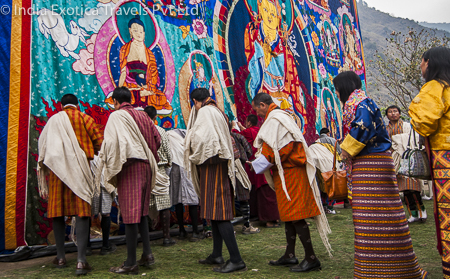
Druk Yul or the ‘Land of Thunder Dragon’, the country as called by Bhutanese is a land replete with myths and legends. The mountains are magnificent, the forest are dense, the people are delightful, the air is pure, the architecture inspiring, the religion exciting and the art superb. Like timeless images from the past, the traveler encounters the full glory of this ancient land through its strategic fortresses known as Dzongs, numerous ancient temples, monasteries and stapes which dot the countryside, prayer flags which flutter along the high ridges, wild animals which abound in dense forests, foamy white waterfalls which are the ethereal showers, and the warm smile of its friendly people. Each moment is special as one discovers a country that the people have chose to preserve in its magical purity.
The differences between eastern and western Bhutan are far greater than the high pass that separates them. Perhaps like the Scots and the English, there are subtle but marked differences. The kingdom was only unified at the end of the last century; prior to that many wars separated each side. The eastern dialect is so different from the western dialect that the two groups find it difficult to understand each other.
Most tourists only visit the western region of Bhutan since Paro has the only airport in Bhutan and most of the east has been closed to tourism. (We are offering a pre-extension if you have never seen Paro, Thimphu, and Punaka). However we are zooming through the west in order to reach a region of Bhutan that foreigners rarely see, because the Sakten valley just opened to tourism. We were the first company to visit the Brokpa people in this region in 2010! It was so great that we had to come back right away because this area will change quickly.
The journey to the East is not easy, but it is one of the most beautiful in all the Himalayas. The main west-east road crosses high passes, traverses through dense forests, and isolated villages. The spectacular mountains of east Bhutan can be seen during clear weather from Thrumshing La (the second highest drivable pass in Bhutan (12,465 ft).
We have also timed the tour so we can see the Gom Kora Tshechu (festival), one of the biggest festivals in eastern Bhutan. The festival draws people from remote villages, school children, village youths, businessmen, civil servants, and the Monpas of the Tawang valley across the border in India. The festival provides a welcome break for locals to trade, socialize, and celebrate before the start of the farming season.
In order to reach the newly opened Sakten Valley of Brokpa tribe, we will be doing a six-day trek. We will reach a maximum sleeping height of 9600 feet.
In the realm of Tibetan culture, the word “Brokpa” actually means animal herder, but is used in Bhutan exclusively as the term for the inhabitants of the Sakteng Valley.
The trek is a gradual climb to reach the Sakteng valley, passing through a few villages on the way. Ponies will carry our main luggage. You need to carry your own daypack for cameras as well as your personal gear and water for the day (not the tour!).
In the camp, we will be using “two-person” tents with mattresses and sleeping bags. (You will need to bring your own sleeping bag; we will provide a comfy pad.) There will be a kitchen and dining tent, as well as the ever important--pit toilet tent. Electricity is not available.
The main source of income of the Brokpa is sheep and yak breeding. From the wool of these working animals the Brokpa women produce artful weavings. The traditional Brokpa costumes are unique to Bhutan. The women wear a garment that resembles a Mexican poncho and a red jacket that, in the lower half, is decorated with woven patterns or with animal figures. The clothing of the men consists of leather gaiters, wool pants and jacket, as well as a sleeveless fur vest, which is worn over the jacket and whose fur can be turned to the outside when raining. Both the men and women where a head cap made of yak felt with several thick long tips, from which the rainwater runs off.
Obviously, this tour is definitely not for everyone. You MUST be in excellent health and already be capable of trekking with your gear for six days in mountainous terrain. The second day of the trek will take almost 8 to 10 hours with a climb from 5700 feet to 9600 feet. (Porters are not available.)
If you have never been to Bhutan you might want to join the Pre-Trip Extension to the sights of western Bhutan. Please see the itinerary after this one.










